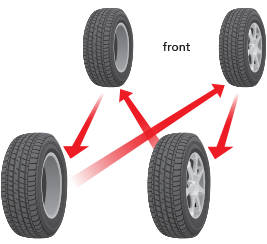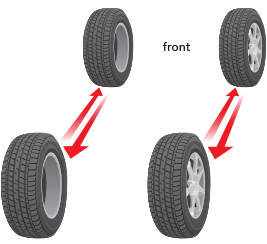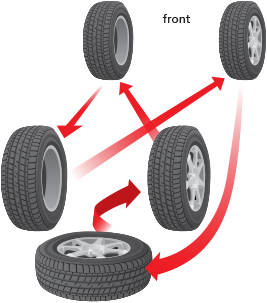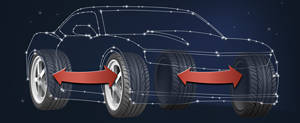What is a tire rotation?
First things first, what's a tire rotation? Simply put, a tire rotation is when you move your tires from their current position to different spots on the vehicle.
While it may sound simple, tire rotations provide massive benefits.
This routine tire maintenance helps your tires perform at their absolute best and even helps extend their tread life. In fact, regular tire rotations can help prevent your tires from developing uneven or irregular wear, tire noise and ride disturbances. Plus, not performing regular tire rotations can void your tire's manufacturer warranty.
How often should I rotate my tires?
Far and away one of the questions we hear most often is "When should I rotate my tires?" The answer is pretty straightforward.
We recommend rotating your tires every 6-8,000 miles, or every other oil change. If your tires develop irregular or uneven wear, you may want to rotate them sooner.
Regular visual inspections can help you catch this. And if you swing by your nearest store for a monthly tire air pressure check, we can inspect them for you, just to make sure your tires are in tip-top shape.
Your next question is probably, "Why do tires develop uneven or irregular wear?" A lot of factors can cause this, including:
-
Improper air pressure
-
Suspension issues
-
Vehicle alignment
-
Rotation intervals
-
Wheel/tire imbalance.
If your tires are showing signs of uneven wear, your best bet is to get them inspected and have them rotated ASAP. Luckily, we know some folks who are pretty good at that sort of thing. (Hint: it's us!)
Tire rotation patterns
There are many different tire rotation patterns, so deciding which one is right for you can feel a little confusing.
But it's actually pretty simple. Both your tire and vehicle type can help you determine which pattern is best to follow. Check out the different rotation patterns illustrated below:

Preferred rotation pattern

Alternate rotation pattern

Preferred directional rotation pattern

Side-to-side staggered rotation

Preferred five-tire rotation

Preferred dual wheel rotation
Looking at the patterns above, you might note that certain tire types can only be rotated in a specific way.
For example, staggered fitment tires can only be rotated from side to side (if the tires aren't directional). If the tires are directional, they'll have to be dismounted and reinstalled facing the opposite direction. Check out our page on tire tread patterns to learn more about directional tires and tread patterns.
When rotating your tires, be sure to double-check the tire air pressure on all of them, including the spare. Some vehicles have different air pressure specs for the front and rear tires, so it's important to keep an eye on that when rotating your rubber.
Another critical factor when rotating your tires is ensuring that all lug nuts have been installed properly and torqued to the manufacturer's specifications.
Rotating in your spare tire
If your ride comes with a full-sized spare, you might be able to use it in the rotation process. This is a nice way to get the most life possible out of all your tires, as well as keep your spare from aging out of use.
Be sure not to mistake a temporary spare tire for a full-size spare tire. The temporary spare is intended for emergency use only.
If you have a full-sized spare and wish to use it in the rotation process, it's easy: just follow the Preferred 5-Tire Rotation shown in the visual above! Here's how it works:
-
Place the full-sized spare tire on the right rear.
-
Make the tire that would've been placed on the right rear the new spare.
If you choose to incorporate your full-sized spare, only do so when it's still relatively new. After too much aging without use, it's best to leave it as your spare.
And if your vehicle has a temporary spare, your routine tire rotations provide an excellent opportunity to inspect the spare tire and check its air pressure.
When checking a temporary spare's air pressure, keep in mind that temporary spare tires typically require a much higher air pressure than regular tires. It's recommended air pressure will be notated on its sidewall, or in the vehicle owner's manual.
It's also important to check your spare's age. Because they don't get used often, temporary spares occasionally need to be replaced due to age. We recommend replacing tires at 6 years of age.
But don't worry, we stock spare tires, and have the lowest prices on them, too.
